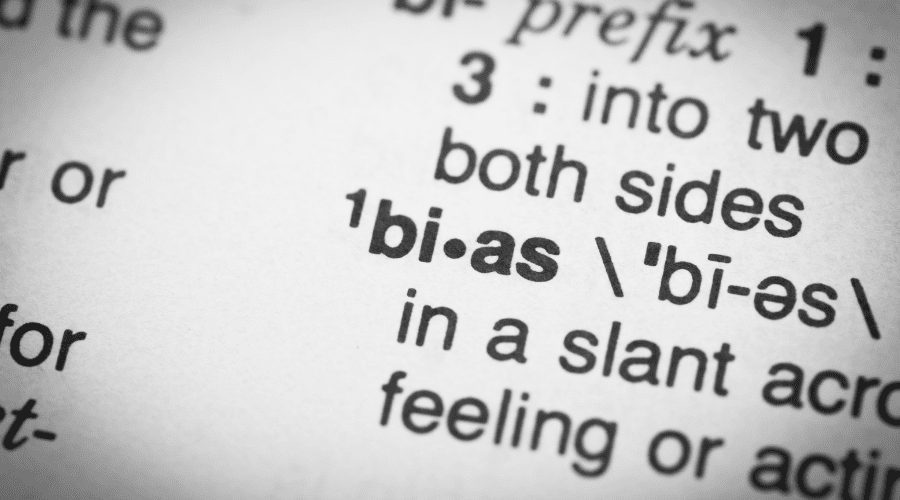Confirmation bias (also referred to as myside bias) is a broad term encompassing a number of individual aspects. At a global level, the term “confirmation bias” refers to an individual’s tendency to search for, interpret, favour and/or recall information in a way that confirms or supports their existing views or values. This process is rarely conscious, but stems from a physiological predisposition to favour the familiar, as it makes us feel safe, and safety is a primary driver for our species.

Our brains are hardwired to simplify and filter the information that we receive, which leaves us predisposed to confirmation bias. The term was originally coined by English psychologist Peter Watson with specific regard to information processing.
Types of confirmation bias:
1. Information seeking:
When tested scientifically, people invariably examine their assumptions in a one-sided way, by actively searching for information that is consistent with their own values, beliefs or assumptions. This commonly includes phrasing questions in a way that receives an affirmative answer to match the one they are expecting, using sources and resources with which they are familiar or which align with their values, or prioritising results which match their expectations while overlooking those that don’t.
How confirmation bias affects language was demonstrated by Shafir E. (1993), who created a fictional child custody case during an experiment. Parent A was a character with general suitability to be a child’s guardian, but with no particularly strong positive or negative characteristics. Parent B was a more extreme character, with strong positive attributes such as a very close emotional relationship with the child, as well as strong negative attributes such as a job that required travel and time away from home.
When asked “Which parent should have custody of the child?” the majority of participants selected Parent B based on the strength of their relationship with the child – the participants focussed on the positive attributes, because the question did the same.
When asked the alternative “Which parent should be denied custody of the child?” the participants’ expectations shifted to the negative, and they cited that Parent B should be denied custody on the basis of extensive travel, giving Parent A custody by default. Different linguistic phrasing creates different answers within the same set of conditions.
2. Information interpretation:
What comes after information collection is of course interpretation. As highlighted in the Shafir case study, individuals can be presented with identical information, but their interpretation can be entirely unique. When we add to this slight variation in the information collected, the interpretation can vary even more widely.
A study by Drew et al. considered data collected during the 2004 U.S. presidential race. The study included participants with a strong feeling about one of the candidates, then showed each participant two apparently contradictory statements reportedly made by each candidate during the race. A third statement was also provided in each case, with an explanation from the candidate as to why their statements contradicted themselves.
From the three pieces of information about each candidate (Republican George W. Bush, Democrat John Kerry, and a third, local neutral public figure in each case), i.e., nine pieces in total, they were asked to decide if each candidate’s statements were inconsistent. Ultimately, the evaluations varied widely, but as a trend, participants were much more likely to interpret the statements as contradictory if they politically opposed that candidate.
This bias is commonly increased with emotional subjects and attachments: the more passionate the individual is about a subject, the stronger the bias can become, and the more this can impact on the interpretation of the information. This bias is also extremely persistent and is not influenced by intelligence level.
3. Biased memory recall:
As part of our memory storage and retrieval process, we create stronger memories when we have a strong emotional attachment. It is why individuals can provide detailed descriptions of events in their life with which they have a particularly happy or sad association. It is why we also vividly remember things which strongly support our views, rather than those which slightly contradict them.
Memory recall is notably unreliable, which is why criminal cases usually present physical evidence alongside witness statements, and why victim statements are secured as soon as possible after the event. Part of this is confirmation bias coming to the fore, with individuals remembering things that selectively reinforce their own opinions, and / or memories of their biased interpretations.
Moreover, memories can change over time, as highlighted in the work by Pierre Janet and Sigmund Freud which identified “false memory syndrome” where someone strongly recalls an event that did not happen, but that they strongly believe did happen. These memories are created through suggestibility, incorporation of misinformation, or source misattribution, and highlight the unreliability of memory.
This memory recall process can ultimately reinforce our bias, as we select and replay information with which we feel most strongly aligned, most familiar, or most comfortable.
Confirmation bias in the real world
Ultimately, our natural expectations and bias carry through to a bias in how we seek and select information. The stronger our beliefs, the stronger our confirmation bias, and most likely the stronger our actual bias. Considering this in the real-world, it is easy to see how facts, evidence, and opinion can be skewed depending on the personal interests and beliefs of the individual, and how two groups can be diametrically opposed based on the same evidence. Recent examples include Brexit in the UK, Coronavirus Vaccinations, Racial Stereotyping in police forces, and Climate Change deniers.

The rise of technology is also a challenge for reducing confirmation bias. Not only does technology bring humans closer together, and better able to find their ‘tribe’ of like-minded people, but it is also programmed to specifically present information that reinforces our bias. On news websites we sign up for newsletters and notifications that deliver information to us with a specific bias, and on social media, confirmation bias is amplified by the algorithms which are specifically designed to present more of the information we engage and interact with, and less of the information that we don’t.
Unless we actively seek out alternative sources of information, we are likely to see more of the information that we already align with, and therefore deepen our confirmation bias. The rule of five is a great way to challenge our own thinking.
One final point to add is that confirmation bias in and of itself is harmless; it is the way in which we use the information that we gather that creates harm. It cannot only skew our perceptions of important issues, confirmation bias leaves us vulnerable to manipulation and coercive control, with individuals and groups.
This creates synergy between their messages and our beliefs, to gain initial influence and control, before contributing to and further skewing your mindset. This is evidenced in cult memberships, religious and political radicalisation, and even abusive relationships, which all mould thoughts, feelings and beliefs over time.
Sources:
- Shafir, E. (1993), “Choosing versus rejecting: why some options are both better and worse than others”, Memory and Cognition, 21 (4): 546–56
- Westen, Drew; Blagov, Pavel S.; Harenski, Keith; Kilts, Clint; Hamann, Stephan (2006), “Neural bases of motivated reasoning: An fMRI study of emotional constraints on partisan political judgment in the 2004 U.S. Presidential election”, Journal of Cognitive Neuroscience, 18 (11): 1947–58

